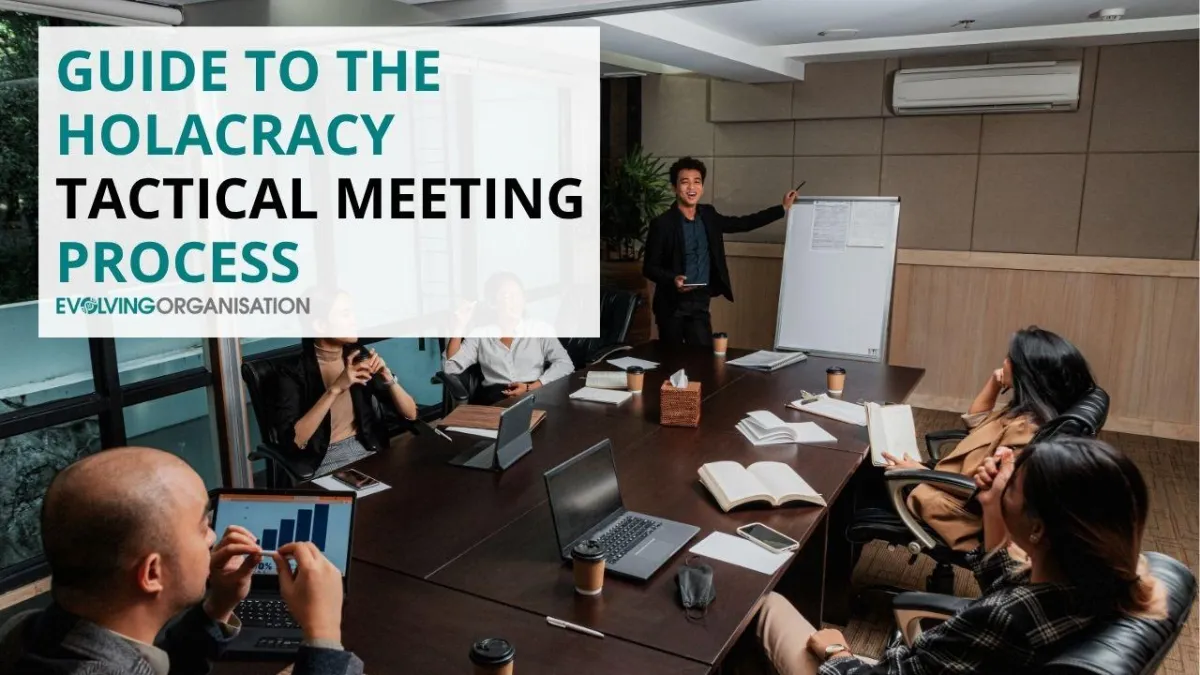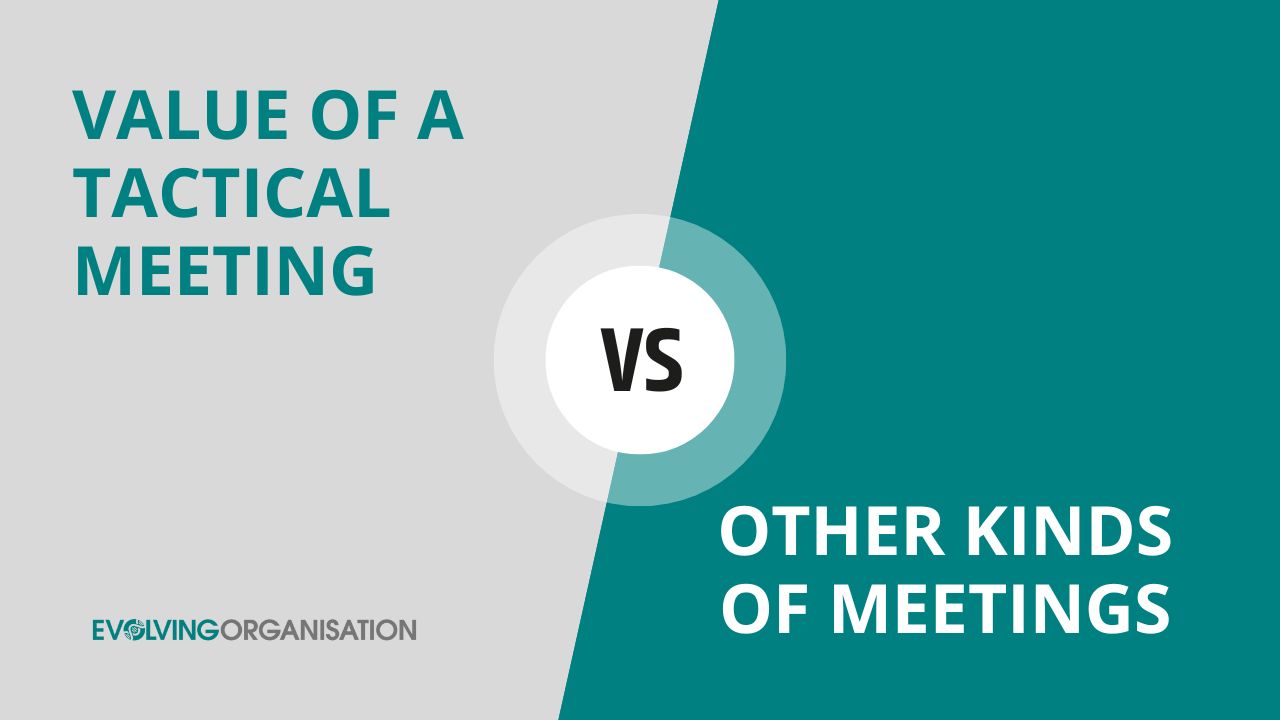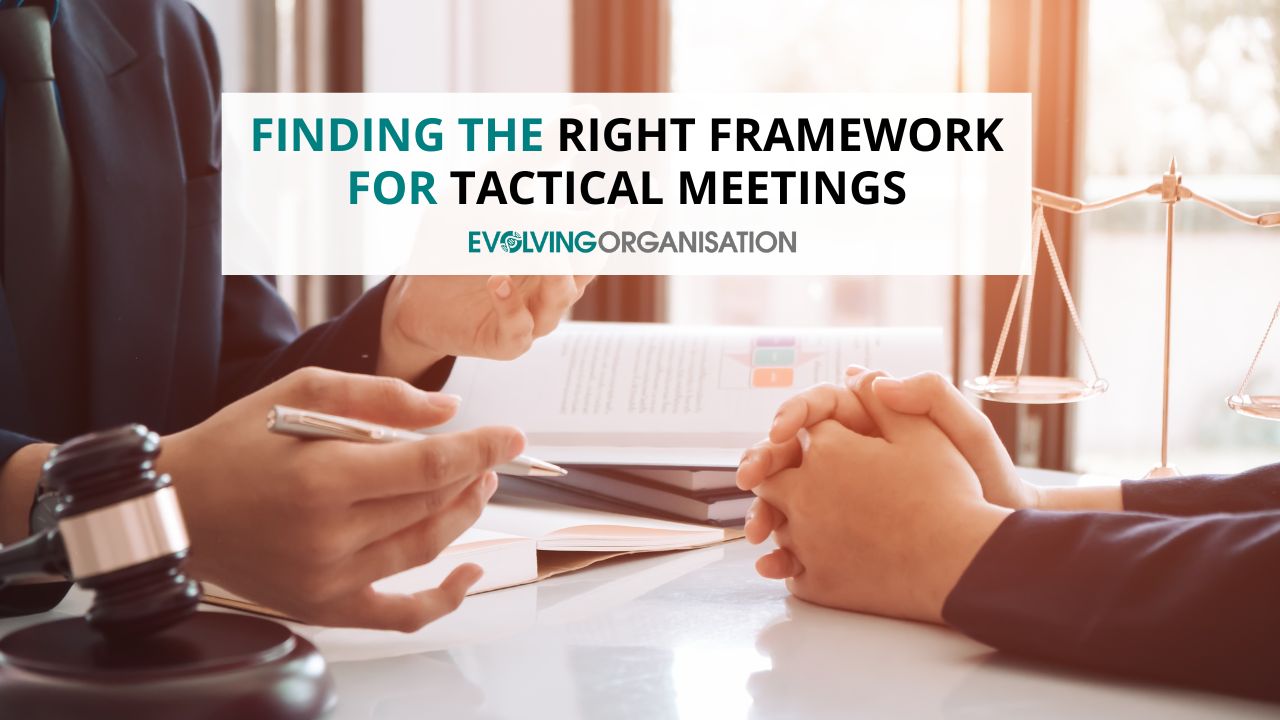
Guide to the Holacracy Tactical Meeting Process
Holacracy Tactical Meetings
Tactical meetings are a core component of Holacracy, designed to enable self-managing teams to operate efficiently and respond swiftly to real-time issues.
They replace traditional status meetings with a structured process that surfaces tensions, discusses immediate concerns, and makes decisions to keep the organisation moving forward. When run correctly, tactical meetings foster clarity, accountability, and agility—key principles in self-organising systems.
This article explains what tactical meetings are, their value, how to run them effectively, and when they should be used.
What are Holacracy Tactical Meetings?
Holacracy tactical meetings are regular, structured gatherings where team members bring up tensions, issues or opportunities that need addressing and quickly figure out the minimum next step to move them forward.
Unlike traditional meetings that often focus on reporting or status updates, tactical meetings are action-oriented and designed to surface and resolve immediate operational concerns quickly. They are a practical tool for maintaining clarity and momentum in a self-managed organisation.
Key features include:
Focus on surfacing tensions from roles and projects.
A clear process for resolving issues.
Actions taken within the authority of specific roles.
Regular cadence, typically weekly or bi-weekly.
In practice:
Team members bring up tensions from their roles, such as a blocked task or resource constraint. The team member who owns the tension leads on figuring out options/requests/next steps, ensuring issues are addressed promptly without unnecessary delays.
What is the Value of a Tactical Meeting vs. Other Kinds of Meetings?

Tactical meetings are distinct because they are designed to create alignment, address operational tensions in real-time, and identify minimum next steps, rather than having lengthy discussions that focus on strategic planning or reporting. Their value lies in:
Maintaining clarity: By surfacing tensions early, teams prevent issues from escalating.
Empowering roles: Decisions are made by those closest to the work, that is, people in their roles, increasing ownership. People usually make decisions in their roles outside of meetings, and they use the meetings to get the input/information they need and remove any obstacles to their decision-making.
Speed and agility: The structured process ensures quick resolution, keeping the organisation responsive.
Focus on the action: Unlike status meetings, tactical meetings prioritize resolving tensions and making decisions, not just sharing updates.
Compared to other meetings, tactical sessions are shorter, more focused, and directly linked to operational execution. They are a vital tool for organisations committed to self-management and distributed authority.
How to Run a Tactical Meeting
Running an effective tactical meeting involves following a clear process that is led by a Facilitator who understands the Tactical Meeting process. It really helps to have a dedicated online meeting platform such as Nestr.io. Holacracy Tactical Meetings run with the following process :

1. Preparation:
Each participant reviews their roles, any checklists, metrics and projects they need to update on and notes any tensions they need to surface.
Prepare to bring up issues or opportunities.
2. Check-in:
Briefly share how everyone is feeling and set the tone.
3. Updates:
The Facilitator invites roles to share updates on Checklists, Metrics and Projects.
4. Build the Agenda:
The Facilitator invites participants to add items to the agenda without discussion. It should take less than a few minutes.
5. Tension Processing:
Each participant presents one tension from their role. This is done one tension at a time, in turn, so that another person's tension doesn't interfere with the person who is processing their tension at that time.
The Facilitator clarifies the relevant roles involved and holds space for the person bringing the tension to get what they need.
Assign owners and any next steps for each tension.
Move on to the next tension and do the same.
6. Closing Round: See below.
Last Round: Closing the Tactical Meeting
The meeting ends with a quick round where each participant is given space, one by one, with no interruptions, to share their reflections on the meeting and how they are feeling/where they are at the end of it.
---
When Would You Recommend Tactical Meetings?

Tactical meetings are best used in organisations that:
Operate with self-managing teams and distributed authority.
Need to address operational tensions quickly and efficiently.
Want to maintain clarity and momentum in day-to-day work?
Are committed to continuous improvement and agile practices.
They are held weekly or bi-weekly, or even only when needed, depending on the organisation's rhythm, and should be integrated into a broader system of governance and strategy.
---
What Advice Would You Give Someone Trying a Tactical Meeting for the First Time?
Stick to the process: Follow the structured steps consistently to build the habits of clarity and rapid processing.
Use a dedicated online meeting platform: To provide visibility and transparency both during and after meetings, such as Nestr.io.
Prepare in advance: Encourage team members to review their roles and note tensions beforehand.
Keep it short: Limit meetings to 30-60 minutes to maintain focus and energy.
Focus on action: Prioritise resolving tensions and figuring out the minimum next steps, not just sharing updates.
Foster psychological safety: Create an environment where everyone feels comfortable surfacing tensions.
Record and follow up: Document decisions and ensure owners are clear on the next steps.
---
Finding the Right Framework for Tactical Meetings

While Holacracy's Tactical Meeting process is highly effective for those teams and organisations that are practising Holacracy, have adopted the Holacracy Constitution and are trained in Holacracy practices, this level of practice isn't the best fit for every Team or organisation.
Other teams and organisations should adapt the practices to fit their unique context. Some teams prefer a lighter or more flexible approach, especially in organisations just starting with self-management. The key is to maintain clarity, focus on tensions, and empower roles to make decisions within their authority.
Incorporate visual tools such as Nestr.io, shared documents, and regular reflection to improve the process continuously. The goal is to embed tactical meetings as a natural part of your organisation's rhythm, supporting ongoing clarity and agility.
---
Tactical Meeting Process
Pre-Meeting Preparation: Review roles and note tensions.
1. Check-in: Space for people to arrive and connect. Set the tone.
2. Updates: Sharing key information before tensions are processed and often generates new tensions to add to the agenda.
3. Build the Agenda: The Facilitator invites roles to add items to the agenda without discussion. It should take less than a few minutes.
4. Process Tensions: Each role owner presents one tension at a time, and the Facilitator holds space for them to identify a minimum next step in moving it forward.
5. Closing Round: Space for each person to give a closing reflection on the meeting, one by one.
You can see more details about each of these steps here.
---
Tactical Meeting Demo
Imagine a team of self-managing software developers. During their weekly tactical meeting:
Each developer presents a tension, such as a blocked API or a resource shortage.
The Team discusses solutions, clarifies responsibilities, and decides who will resolve each issue.
Owners are assigned, and the next steps are recorded.
The meeting ends with a quick round, confirming everyone understands their commitments.
This process keeps the Team aligned, proactive, and responsive.
Here's a demo of a team's first Tactical Meeting.
Your first Holacracy Tactical Meeting – Actual meeting (with annotations!)
Examples of Tactical Meetings
A marketing team surfaces tensions around campaign deadlines, discusses options, and assigns responsibility for adjustments.
An operations team addresses a supply chain delay, decides on alternative suppliers, and assigns owners.
A product team resolves a technical blocker by clarifying roles and agreeing on immediate actions.
Here's a recording of a real Holacracy Tactical Meeting from Springest:
Holacracy Tactical & Governance meeting at Springest
---
This approach to tactical meetings, rooted in self-organising teams and distributed authority, ensures operational clarity and responsiveness. When used consistently, it empowers teams to work more effectively, adapt swiftly, and maintain momentum, which is fundamental in today's complex, fast-changing environment.
Holacracy can be adopted in full, or just the practices that suit a specific team or organisation can be adopted. If you are interested on embarking on this journey, we can help you to assess your organisation's readiness and ensure you have the resources and mindset to sustain the change.
Take our free 10-minute Team Needs check here to find out if your Team has needs that this approach could help. Our Team Clarity & Faster Decision-Making program can help you adopt Holacracy practices fully or partially. With the right approach, such post-hierarchical ways of working can be a powerful tool for navigating today's complex and uncertain business landscape.
Suppose you want to learn these practices in depth. In that case, programs like Team Clarity & Faster Decision-Making and The Meetings Revolution offer step-by-step guidance and practical tools to help your Team make these shifts confidently and effectively.
When you move beyond hierarchy and empower your Team to own their roles, communicate openly, and adapt quickly, you don't just improve performance—you create the foundation for lasting success in a fast-changing world.
This blog serves as a continuation of our commitment to improving performance and decision-making within organisations. Stay tuned for our next instalment, where we will delve deeper into a range of practical tools that do this.
For more insights and resources, visit our website. Together, let's evolve and adapt to the challenges of our dynamic world and build a better, more collaborative future—together.


